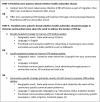Perspectives of Vietnamese, Sudanese and South Sudanese immigrants on targeting migrant communities for latent tuberculosis screening and treatment in low-incidence settings: A report on two Victorian community panels
- PMID: 32918523
- PMCID: PMC7752196
- DOI: 10.1111/hex.13121
Perspectives of Vietnamese, Sudanese and South Sudanese immigrants on targeting migrant communities for latent tuberculosis screening and treatment in low-incidence settings: A report on two Victorian community panels
Abstract
Background: Tuberculosis (TB) elimination strategies in Australia require a focus on groups who are at highest risk of TB infection, such as immigrants from high-burden settings. Understanding attitudes to different strategies for latent TB infection (LTBI) screening and treatment is an important element of justifiable elimination strategies.
Method: Two community panels were conducted in Melbourne with members of the Vietnamese (n = 11), Sudanese and South Sudanese communities (n = 9). Panellists were provided with expert information about LTBI and different screening and health communication strategies, then deliberated on how best to pursue TB elimination in Australia.
Findings: Both panels unanimously preferred LTBI screening to occur pre-migration rather than in Australia. Participants were concerned that post-migration screening would reach fewer migrants, noted that conducting LTBI screening in Australia could stigmatize participants and that poor awareness of LTBI would hamper participation. If targeted screening was to occur in Australia, the Vietnamese panel preferred 'place-based' communication strategies, whereas the Sudanese and South Sudanese panel emphasized that community leaders should lead communication strategies to minimize stigma. Both groups emphasized the importance of maintaining community trust in Australian health service providers, and the need to ensure targeting did not undermine this trust.
Conclusion: Pre-migration screening was preferred. If post-migration screening is necessary, the potential for stigma should be reduced, benefit and risk profile clearly explained and culturally appropriate communication strategies employed. Cultural attitudes to health providers, personal health management and broader social vulnerabilities of targeted groups need to be considered in the design of screening programs.
Keywords: Australia; deliberative methodologies; latent tuberculosis; migrant health; population screening.
© 2020 The Authors. Health Expectations published by John Wiley & Sons Ltd.
Conflict of interest statement
Justin Denholm is the Director of the Victorian Tuberculosis Program. All other authors have no conflicts of interest to declare.
Similar articles
-
Insights into culturally appropriate latent tuberculosis infection (LTBI) screening in NSW: perspectives of Indian and Pakistani migrants.Aust N Z J Public Health. 2020 Oct;44(5):353-359. doi: 10.1111/1753-6405.13021. Epub 2020 Aug 10. Aust N Z J Public Health. 2020. PMID: 32776658
-
Strategies to reach and motivate migrant communities at high risk for TB to participate in a latent tuberculosis infection screening program: a community-engaged, mixed methods study among Eritreans.BMC Public Health. 2020 Mar 12;20(1):315. doi: 10.1186/s12889-020-8390-9. BMC Public Health. 2020. PMID: 32164637 Free PMC article.
-
Modeling the Cost-Effectiveness of Latent Tuberculosis Screening and Treatment Strategies in Recent Migrants to a Low-Incidence Setting.Am J Epidemiol. 2022 Jan 24;191(2):255-270. doi: 10.1093/aje/kwab150. Am J Epidemiol. 2022. PMID: 34017976
-
Screening for tuberculosis in migrants and visitors from high-incidence settings: present and future perspectives.Eur Respir J. 2018 Jul 11;52(1):1800591. doi: 10.1183/13993003.00591-2018. Print 2018 Jul. Eur Respir J. 2018. PMID: 29794133 Review.
-
Recommendations for the screening of paediatric latent tuberculosis infection in indigenous communities: a systematic review of screening strategies among high-risk groups in low-incidence countries.BMC Public Health. 2018 Aug 6;18(1):979. doi: 10.1186/s12889-018-5886-7. BMC Public Health. 2018. PMID: 30081879 Free PMC article.
Cited by
-
Gender-Specific Association Between Perceived Stigma Toward Tuberculosis and Acceptance of Preventive Treatment Among College Students With Latent Tuberculosis Infection: Cross-Sectional Analysis.JMIR Public Health Surveill. 2023 Jun 14;9:e43972. doi: 10.2196/43972. JMIR Public Health Surveill. 2023. PMID: 37314847 Free PMC article.
-
Detecting Mycobacterium tuberculosis Infection in Children Migrating to Australia.Emerg Infect Dis. 2022 Sep;28(9):1833-1841. doi: 10.3201/eid2809.212426. Emerg Infect Dis. 2022. PMID: 35997353 Free PMC article.
-
Barriers and facilitators of tuberculosis treatment among immigrants: an integrative review.BMC Public Health. 2024 Dec 18;24(1):3514. doi: 10.1186/s12889-024-21020-8. BMC Public Health. 2024. PMID: 39696110 Free PMC article.
References
-
- Uplekar M, Weil D, Lonnroth K, et al. WHO's new end TB strategy. Lancet. 2015;385(9979):1799‐1801. - PubMed
-
- World Health Organization . Towards Tuberculosis Elimination: An Action Framework In Low‐Incidence Countries. Geneva, Switzerland: WHO; 2014. 9241507705.
-
- Toms C, Stapledon R, Waring J, Douglas P. Tuberculosis notifications in Australia, 2012 and 2013. Commun Dis Intell Q Rep. 2015;39(2):E217‐E235. - PubMed
-
- Mack U, Migliori GB, Sester M, et al. LTBI: latent tuberculosis infection or lasting immune responses to M. tuberculosis? A TBNET consensus statement. Eur Respir J. 2009;33(5):956‐973. - PubMed
-
- Salgame P, Geadas C, Collins L, Jones‐López E, Ellner JJ. Latent tuberculosis infection – revisiting and revising concepts. Tuberculosis. 2015;95(4):373‐384. - PubMed
Publication types
MeSH terms
LinkOut - more resources
Full Text Sources


